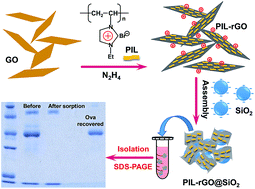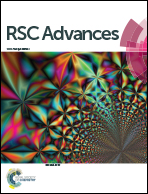Polymeric ionic liquid modified reduced graphene oxide as adsorbent for highly selective isolation of acidic protein†
Abstract
Polymeric ionic liquid (PIL), poly(1-vinyl-3-ethylimidazolium bromide) (P(ViEtIm+Br−)), modified reduced graphene oxide (rGO) nanosheets (PIL–rGO) are prepared during the reduction process using hydrazine hydrate. The as-prepared PIL–rGO is further self-assembled onto the surface of SiO2 nanoparticles through electrostatic interactions as demonstrated by TEM & SEM images. The obtained PIL–rGO@SiO2 nano-hybrid exhibits highly selective adsorption toward acidic protein, i.e., ovalbumin (Ova) as a model in the present case. The strong electrostatic attractions and π–π interactions between Ova and the nano-hybrid are the main driving forces for protein adsorption. An adsorption efficiency of ca. 95% is achieved for 150 mg L−1 Ova in a 4 mM B–R buffer at pH 5, along with an ultra-high adsorption capacity of ca. 917.4 mg g−1 as compared to those adsorbents for similar purposes. The adsorbed Ova could be effectively recovered from the surface of the nano-hybrid by using a 0.4% (w/v) SDS solution, giving rise to a recovery of ca. 70%. The practical applicability of the PIL–rGO@SiO2 nano-hybrid is demonstrated by selective isolation and removal of Ova from a complex biological sample matrix, i.e., chicken egg white.


 Please wait while we load your content...
Please wait while we load your content...